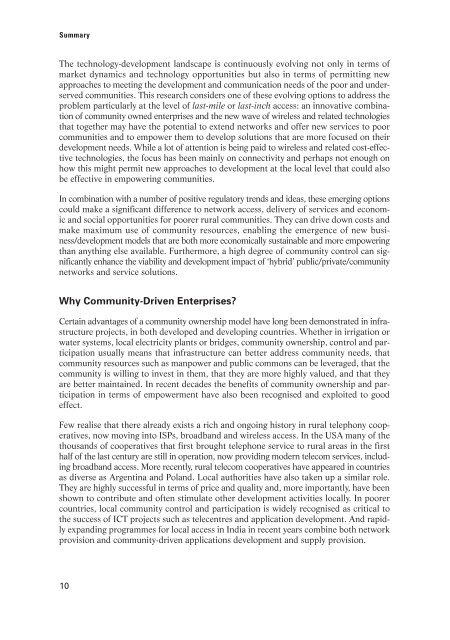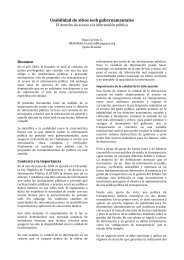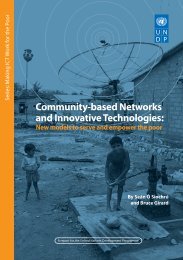Community-based Networks and Innovative Technologies: New ...
Community-based Networks and Innovative Technologies: New ...
Community-based Networks and Innovative Technologies: New ...
Create successful ePaper yourself
Turn your PDF publications into a flip-book with our unique Google optimized e-Paper software.
SummaryThe technology-development l<strong>and</strong>scape is continuously evolving not only in terms ofmarket dynamics <strong>and</strong> technology opportunities but also in terms of permitting newapproaches to meeting the development <strong>and</strong> communication needs of the poor <strong>and</strong> underservedcommunities. This research considers one of these evolving options to address theproblem particularly at the level of last-mile or last-inch access: an innovative combinationof community owned enterprises <strong>and</strong> the new wave of wireless <strong>and</strong> related technologiesthat together may have the potential to extend networks <strong>and</strong> offer new services to poorcommunities <strong>and</strong> to empower them to develop solutions that are more focused on theirdevelopment needs. While a lot of attention is being paid to wireless <strong>and</strong> related cost-effectivetechnologies, the focus has been mainly on connectivity <strong>and</strong> perhaps not enough onhow this might permit new approaches to development at the local level that could alsobe effective in empowering communities.In combination with a number of positive regulatory trends <strong>and</strong> ideas, these emerging optionscould make a significant difference to network access, delivery of services <strong>and</strong> economic<strong>and</strong> social opportunities for poorer rural communities. They can drive down costs <strong>and</strong>make maximum use of community resources, enabling the emergence of new business/developmentmodels that are both more economically sustainable <strong>and</strong> more empoweringthan anything else available. Furthermore, a high degree of community control can significantlyenhance the viability <strong>and</strong> development impact of ‘hybrid’ public/private/communitynetworks <strong>and</strong> service solutions.Why <strong>Community</strong>-Driven Enterprises?Certain advantages of a community ownership model have long been demonstrated in infrastructureprojects, in both developed <strong>and</strong> developing countries. Whether in irrigation orwater systems, local electricity plants or bridges, community ownership, control <strong>and</strong> participationusually means that infrastructure can better address community needs, thatcommunity resources such as manpower <strong>and</strong> public commons can be leveraged, that thecommunity is willing to invest in them, that they are more highly valued, <strong>and</strong> that theyare better maintained. In recent decades the benefits of community ownership <strong>and</strong> participationin terms of empowerment have also been recognised <strong>and</strong> exploited to goodeffect.Few realise that there already exists a rich <strong>and</strong> ongoing history in rural telephony cooperatives,now moving into ISPs, broadb<strong>and</strong> <strong>and</strong> wireless access. In the USA many of thethous<strong>and</strong>s of cooperatives that first brought telephone service to rural areas in the firsthalf of the last century are still in operation, now providing modern telecom services, includingbroadb<strong>and</strong> access. More recently, rural telecom cooperatives have appeared in countriesas diverse as Argentina <strong>and</strong> Pol<strong>and</strong>. Local authorities have also taken up a similar role.They are highly successful in terms of price <strong>and</strong> quality <strong>and</strong>, more importantly, have beenshown to contribute <strong>and</strong> often stimulate other development activities locally. In poorercountries, local community control <strong>and</strong> participation is widely recognised as critical tothe success of ICT projects such as telecentres <strong>and</strong> application development. And rapidlyexp<strong>and</strong>ing programmes for local access in India in recent years combine both networkprovision <strong>and</strong> community-driven applications development <strong>and</strong> supply provision.10
















